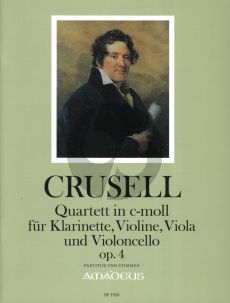The clarinettist Bernhard Henrik Crusell (1775-1838) was more than a virtuoso writing Works as a vehicle for His own performances. His compositions are today recognized as among the best in the clarinet repertoire of the early nineteenth century. The heyday of the wind virtuoso, during which he lived, came at a time when great changes were taking place in the style and taste of musical composition. The style established by Mozart and Haydn was first transformed by Beethoven and then considerably released from its fetters by the early romantics. Crusell played an important part in adapting these transitions to compositions for the clarinet. Early works for the instrument by Karl Stamitz and the virtuosi Michael Yost and Xavier Lefèvre had been severly restricted by the limited capabilities and range of the clarinet. Then in the 1790s Franz Tausch, the great teacher and performer, set unbelievably high standards in technical difficulty and range, especially as far as the altissimo register was concerned. At the same period Mozart, thanks to Anton Stadler's extended clarinet, was revealing the beauties of the chalumeau register in a way which had never been done before. After the turn of the century Crusell followed their leads but limited his upper range, as did Mozart, to g in alt. Crusell was born in Finland into a family of bookbinders. His early display of a passion for music was frowned upon and at the age of thirteen a benefactor whisked him away from his parents - whom he saw only once more - to become an apprentice in a military band at Sveaborg. In 1791 the band was transferred to Stockholm, which became Crusell's home for the rest of his life. From 1801 to 1833 he was principal clarinettist in the Swedish court orchestra and earned a reputation as one of the finest soloists of his time. He first studied composition with the Abbé Vogler in Stockholm and then in 1798 spent seven months studying the clarinet with Tausch in Berlin. In 1803 he journeyed to Paris to study composition further with Berton and Gossec. In both 1811 and 1822 he travelled to Leipzig to get his compositions published. Crusell's travel diaries show him to have been intensely curious to learn all he could about the general culture of the countries he was visiting. He made himself fluent in several languages and also, not surprisingly in view of his heritage, had a strong interest in literature. He joined Sweden's Gothic Society and set to music poems of some of the eminent men of letters whom he met withing its walls. With the exception of his 1798 journey, Crusell's tours were all taken in the entourage of noble or notable persons, and it is not surprising to find that, such was his carefully acquired breeding, he was treated by his patrons as friend and companion, rather than servant. The dedications of Crusell's compositions are thus not always mere courtesies but often tokens of true friendship. The Opus 2 quartet, which may have been written as early as 1803 but was not published until 1812, bears no dedication. Opus 4, written circa 1804, is dedicated to the diplomat Monsieur Genséric Brandel (1782-1833) who was Counsellor at the Swedish Legation in St Petersburg when his work was published in 1816. Crusell had been friends with Brandel since before his Paris journey. It is thought that Brandel took the initiative in asking the Tsar's permission for Crusell dedicate a work to him (Concerto N.║ 2, Opus 5). Opus 7, written circa 1821 and published in 1823, is dedicated to the diplomat and soldier Count Gustaf Carl Fredrik Loewenhielm (1771-1856). Count Loewenhielm was responsible for planning SweedenÆs successful campaign against Napoleon. In 1814 he was elected to Sweden's Musical Academy and was in close contact with Crusell who was, at this time, director of the court theatre. Crusell's Flute Quartet, Opus 8, which he also dedicated to the Count, is almost identical to Opus 7 but with slight modifications on the flute. Works for clarinet and string trio were popular in Crusells day for private chamber-music evenings rather than the concert platform. Crusell's three quartets have the usual four movements in traditional classical forms. His first movements are all sonata form. Whilst the slow movements of Opp 2 and 4 are in ternary form, that of Op 7 is a rondo ('un poco Largo') and the finale of this quartet is in sonata form. The Minuet and Trio of Op 4 is made the second rather than the usual third movement. Crusell changes his key for the slow movements only: subdominant for Op. 2, relative major for Op 4 and dominant for Op 7.










